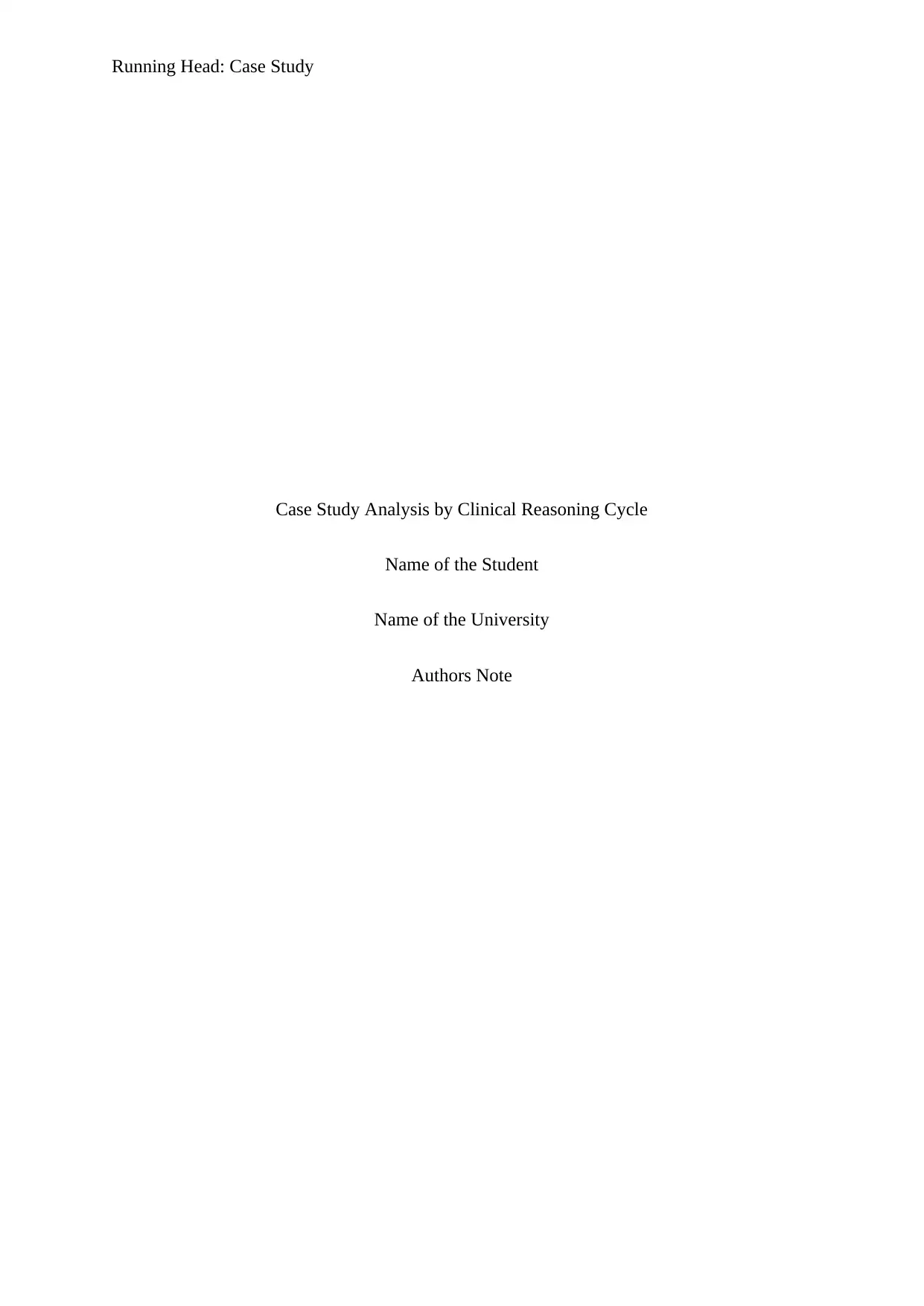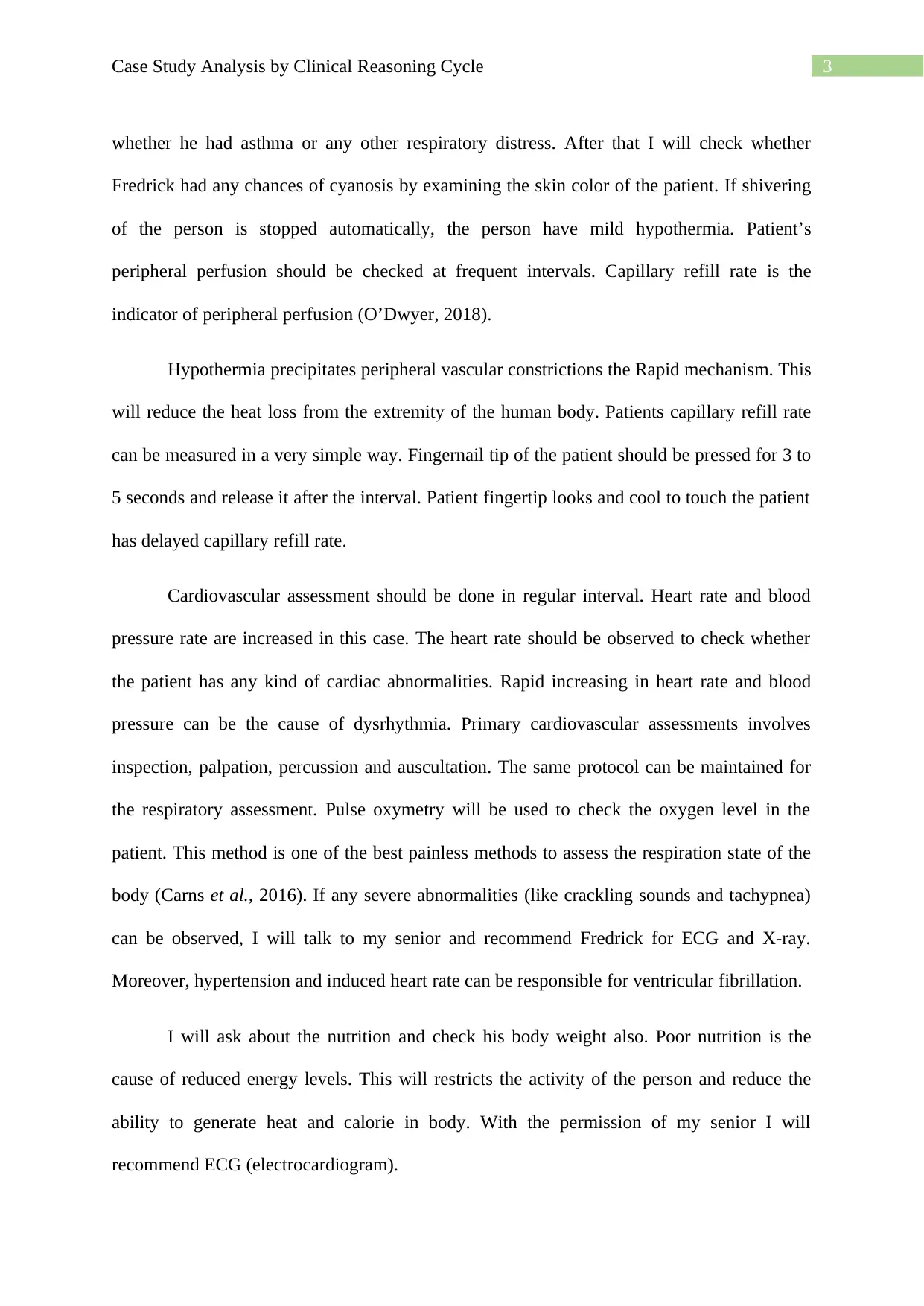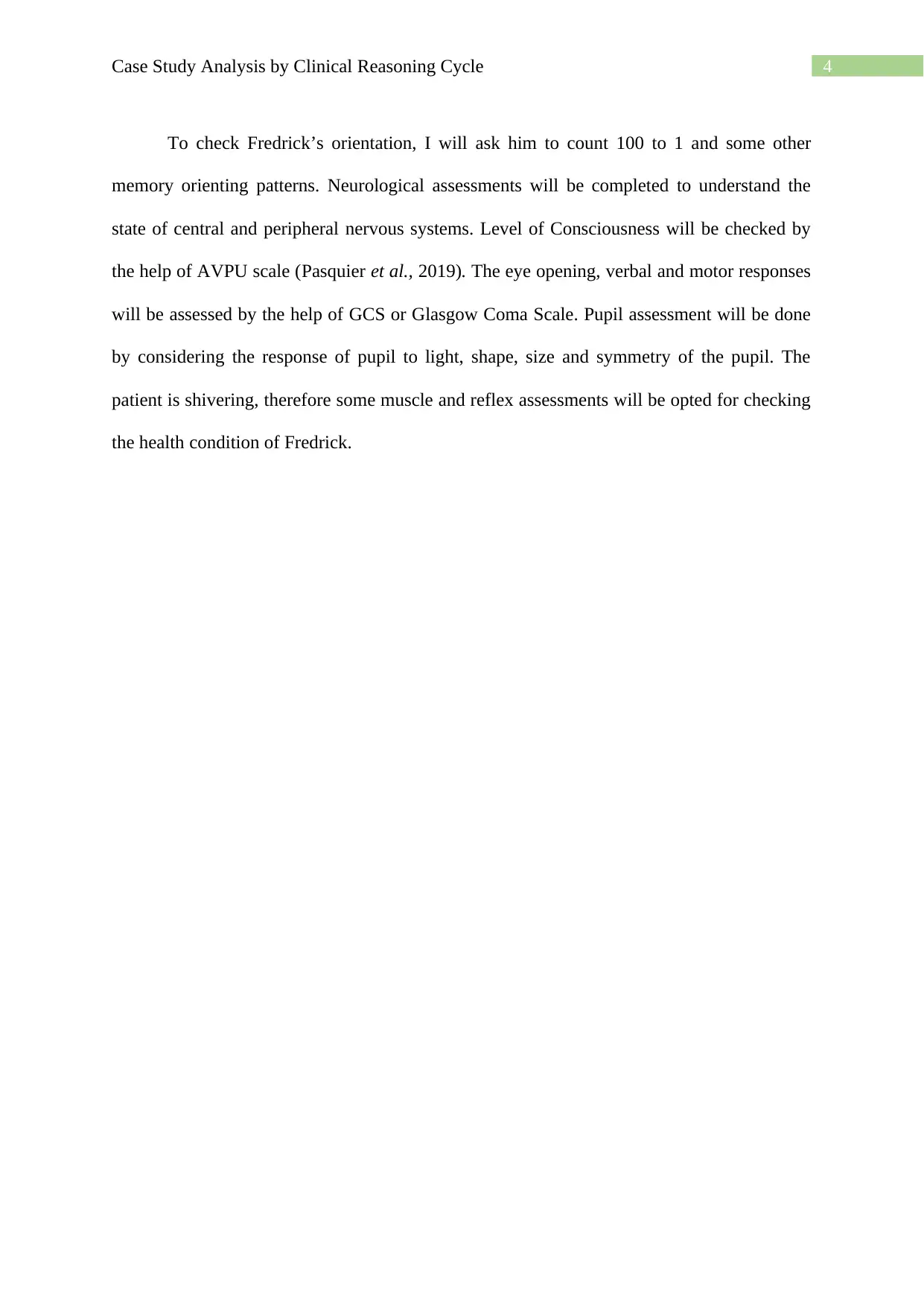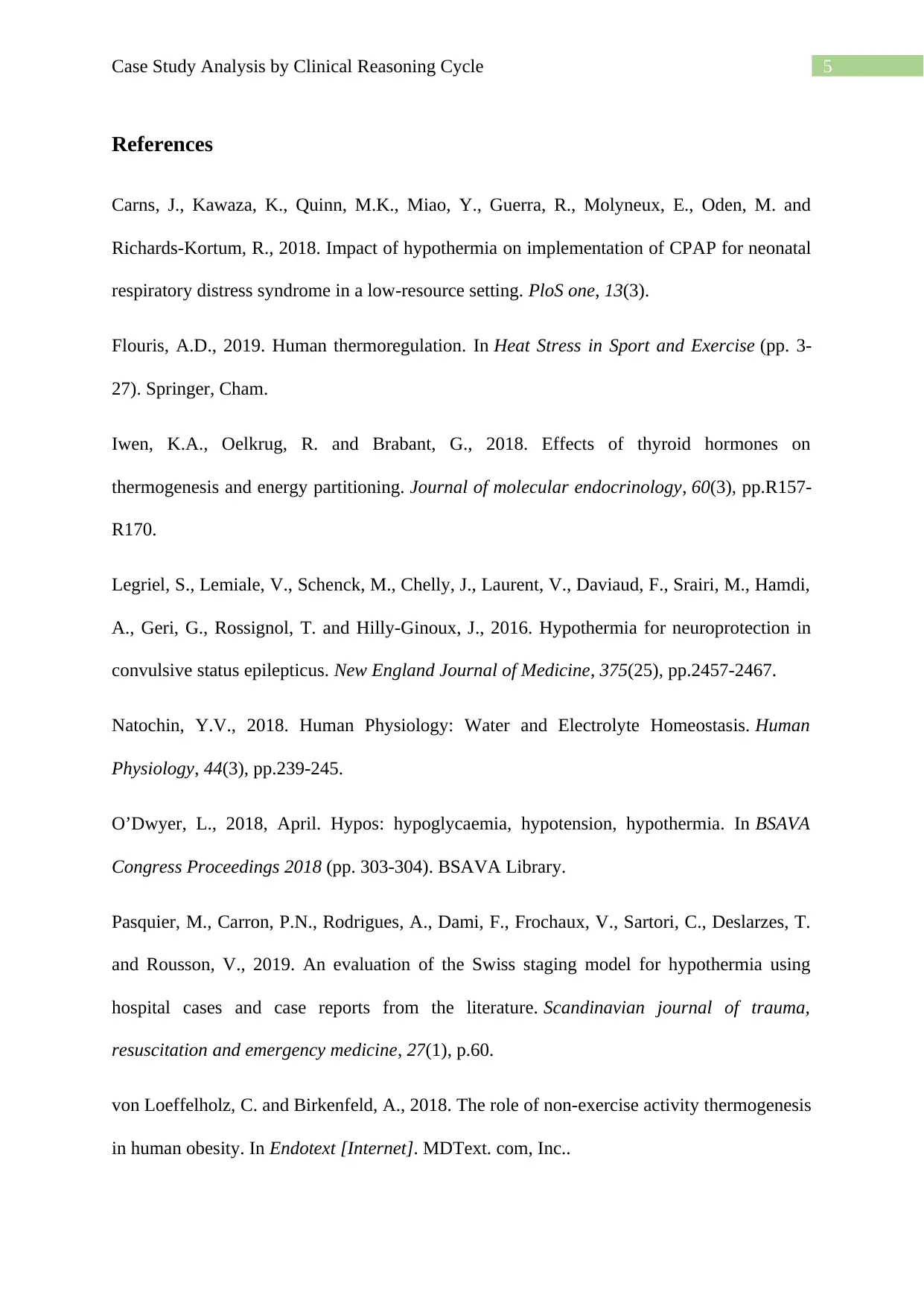Case Study Analysis: Clinical Reasoning Cycle - CNA152
VerifiedAdded on 2022/09/14
|6
|1488
|23
Case Study
AI Summary
This case study analyzes the case of a 63-year-old elderly patient, Frederick, who experienced hypothermia after cold water swimming. The analysis, conducted using the clinical reasoning cycle, begins with collecting cues, including subjective observations like shivering and objective measurements such as blood pressure (150/84 mmHg), respiratory rate (24 bpm), pulse rate (102 bpm), and temperature (35°C). The analysis interprets these findings, explaining how the cold environment and water temperature triggered the body's thermoregulatory mechanisms, leading to vasoconstriction, shivering, and increased heart and respiratory rates. The study identifies the patient's potential risk of hypothermia and proposes further cues, including respiratory, cardiovascular, and neurological assessments, along with inquiries about the patient's medical history and nutritional status. It also recommends ECG and X-rays if any severe abnormalities are found. The student applies knowledge of anatomy and physiology to explain the assessment findings. The analysis concludes by outlining the need for assessments to determine the patient's level of consciousness and neurological function.

Running Head: Case Study
Case Study Analysis by Clinical Reasoning Cycle
Name of the Student
Name of the University
Authors Note
Case Study Analysis by Clinical Reasoning Cycle
Name of the Student
Name of the University
Authors Note
Paraphrase This Document
Need a fresh take? Get an instant paraphrase of this document with our AI Paraphraser

1Case Study Analysis by Clinical Reasoning Cycle
Patient’s Situation
Frederick is a 63 years old elderly person and he has tried the cold water swimming
for the first time. The person was shivering and his hands are very cold. He is very old person
that is why I wanted to know his premedical history but that could not be accessed due to
network problem.
Collecting the cues
Different cues such as subjective and objective cues are collected by observing
Frederick. Blood Pressure, heart rate, body temperature and respiratory rate are considered as
the objective cues. His blood pressure was assessed that 150/84 mmHg. His respiratory rate is
24 bpm and pulse rate is 102 beats per minute. His temperature was 35 C. However, the
previous records of the person showed that his blood pressure is not much varied from the
normal blood pressure. His pulse is slightly elevated and the temperature has been decreased.
Analyze and interpret the situation
Body temperature is regulated by the mechanism of homeostasis. Homeostasis
helps the human body to maintain a temperature regulation by the help of negative and
positive feed backs (von Loeffelholz and Birkenfeld, 2018). Change in temperature, outside
of human body does not regulate the internal body temperature of a human. Increasing and
decreasing of temperature outside of the body act as a stimuli for human body (Flouris,
2019). When the temperature is cold outside, internal body temperature is also decreased. The
hypothalamus will send signals to body muscles and glands to balance the internal body
temperature. The subjective cues are the skin color and shivering of the patient.
Patient’s Situation
Frederick is a 63 years old elderly person and he has tried the cold water swimming
for the first time. The person was shivering and his hands are very cold. He is very old person
that is why I wanted to know his premedical history but that could not be accessed due to
network problem.
Collecting the cues
Different cues such as subjective and objective cues are collected by observing
Frederick. Blood Pressure, heart rate, body temperature and respiratory rate are considered as
the objective cues. His blood pressure was assessed that 150/84 mmHg. His respiratory rate is
24 bpm and pulse rate is 102 beats per minute. His temperature was 35 C. However, the
previous records of the person showed that his blood pressure is not much varied from the
normal blood pressure. His pulse is slightly elevated and the temperature has been decreased.
Analyze and interpret the situation
Body temperature is regulated by the mechanism of homeostasis. Homeostasis
helps the human body to maintain a temperature regulation by the help of negative and
positive feed backs (von Loeffelholz and Birkenfeld, 2018). Change in temperature, outside
of human body does not regulate the internal body temperature of a human. Increasing and
decreasing of temperature outside of the body act as a stimuli for human body (Flouris,
2019). When the temperature is cold outside, internal body temperature is also decreased. The
hypothalamus will send signals to body muscles and glands to balance the internal body
temperature. The subjective cues are the skin color and shivering of the patient.

2Case Study Analysis by Clinical Reasoning Cycle
As Fredrick is an elderly person, he might face problem regarding hypothermia. The
outer temperature is 19˚ C and the water temperature (17˚ C) is colder. Low temperature of
the environment will regulate the hypothalamus. As his body temperature has been lowered
to 35˚ C therefore body needs to increase the temperature. The blood vessels become
narrower to preventing the body from releasing heat. Blood vessels under the skin are
constricted and conserve the heat in the body. Thermogenesis is the process of heat
production. When the body temperature is lowering down the body will take help of
thermogenesis. Body muscles produce the heat by shivering (Natochin, 2018). Hormonal
thermogenesis is another process where thyroid hormone will be released and will be
produced heat (Iwen, Oelkrug, and Brabant, 2018.). Fredrick’s body was suffered from
hypothermia. The symptoms of hypothermia is very ambiguous as this influence both the
nervous and musculoskeletal system (Legriel et al., 2016). As neuro-sympathetic excitation
occurs in the body; high blood pressure, fast heart rate and high respiratory rate can be
observed.
Fredrick was also showing the similar signs and symptoms such as his heart rate has
been increased from 78 bpm to 102 bpm. Heart rate increases to increase the blood
circulation in the body during fast heart rate the blood pressure is also increased. Therefore
during vasoconstriction the person will not suffer from deoxygenation. The blood pressure
will be increased in the patient. Due to hypothermia and increased blood pressure, the
respiratory rate will be increased. The temperature of the body has also decreased from the
previous readings.
Further cues and rationale
No previous medical history has found for the patient. Fredrick is showing higher
respiratory rate, therefore respiratory assessment should be done. I would ask Frederick
As Fredrick is an elderly person, he might face problem regarding hypothermia. The
outer temperature is 19˚ C and the water temperature (17˚ C) is colder. Low temperature of
the environment will regulate the hypothalamus. As his body temperature has been lowered
to 35˚ C therefore body needs to increase the temperature. The blood vessels become
narrower to preventing the body from releasing heat. Blood vessels under the skin are
constricted and conserve the heat in the body. Thermogenesis is the process of heat
production. When the body temperature is lowering down the body will take help of
thermogenesis. Body muscles produce the heat by shivering (Natochin, 2018). Hormonal
thermogenesis is another process where thyroid hormone will be released and will be
produced heat (Iwen, Oelkrug, and Brabant, 2018.). Fredrick’s body was suffered from
hypothermia. The symptoms of hypothermia is very ambiguous as this influence both the
nervous and musculoskeletal system (Legriel et al., 2016). As neuro-sympathetic excitation
occurs in the body; high blood pressure, fast heart rate and high respiratory rate can be
observed.
Fredrick was also showing the similar signs and symptoms such as his heart rate has
been increased from 78 bpm to 102 bpm. Heart rate increases to increase the blood
circulation in the body during fast heart rate the blood pressure is also increased. Therefore
during vasoconstriction the person will not suffer from deoxygenation. The blood pressure
will be increased in the patient. Due to hypothermia and increased blood pressure, the
respiratory rate will be increased. The temperature of the body has also decreased from the
previous readings.
Further cues and rationale
No previous medical history has found for the patient. Fredrick is showing higher
respiratory rate, therefore respiratory assessment should be done. I would ask Frederick
⊘ This is a preview!⊘
Do you want full access?
Subscribe today to unlock all pages.

Trusted by 1+ million students worldwide

3Case Study Analysis by Clinical Reasoning Cycle
whether he had asthma or any other respiratory distress. After that I will check whether
Fredrick had any chances of cyanosis by examining the skin color of the patient. If shivering
of the person is stopped automatically, the person have mild hypothermia. Patient’s
peripheral perfusion should be checked at frequent intervals. Capillary refill rate is the
indicator of peripheral perfusion (O’Dwyer, 2018).
Hypothermia precipitates peripheral vascular constrictions the Rapid mechanism. This
will reduce the heat loss from the extremity of the human body. Patients capillary refill rate
can be measured in a very simple way. Fingernail tip of the patient should be pressed for 3 to
5 seconds and release it after the interval. Patient fingertip looks and cool to touch the patient
has delayed capillary refill rate.
Cardiovascular assessment should be done in regular interval. Heart rate and blood
pressure rate are increased in this case. The heart rate should be observed to check whether
the patient has any kind of cardiac abnormalities. Rapid increasing in heart rate and blood
pressure can be the cause of dysrhythmia. Primary cardiovascular assessments involves
inspection, palpation, percussion and auscultation. The same protocol can be maintained for
the respiratory assessment. Pulse oxymetry will be used to check the oxygen level in the
patient. This method is one of the best painless methods to assess the respiration state of the
body (Carns et al., 2016). If any severe abnormalities (like crackling sounds and tachypnea)
can be observed, I will talk to my senior and recommend Fredrick for ECG and X-ray.
Moreover, hypertension and induced heart rate can be responsible for ventricular fibrillation.
I will ask about the nutrition and check his body weight also. Poor nutrition is the
cause of reduced energy levels. This will restricts the activity of the person and reduce the
ability to generate heat and calorie in body. With the permission of my senior I will
recommend ECG (electrocardiogram).
whether he had asthma or any other respiratory distress. After that I will check whether
Fredrick had any chances of cyanosis by examining the skin color of the patient. If shivering
of the person is stopped automatically, the person have mild hypothermia. Patient’s
peripheral perfusion should be checked at frequent intervals. Capillary refill rate is the
indicator of peripheral perfusion (O’Dwyer, 2018).
Hypothermia precipitates peripheral vascular constrictions the Rapid mechanism. This
will reduce the heat loss from the extremity of the human body. Patients capillary refill rate
can be measured in a very simple way. Fingernail tip of the patient should be pressed for 3 to
5 seconds and release it after the interval. Patient fingertip looks and cool to touch the patient
has delayed capillary refill rate.
Cardiovascular assessment should be done in regular interval. Heart rate and blood
pressure rate are increased in this case. The heart rate should be observed to check whether
the patient has any kind of cardiac abnormalities. Rapid increasing in heart rate and blood
pressure can be the cause of dysrhythmia. Primary cardiovascular assessments involves
inspection, palpation, percussion and auscultation. The same protocol can be maintained for
the respiratory assessment. Pulse oxymetry will be used to check the oxygen level in the
patient. This method is one of the best painless methods to assess the respiration state of the
body (Carns et al., 2016). If any severe abnormalities (like crackling sounds and tachypnea)
can be observed, I will talk to my senior and recommend Fredrick for ECG and X-ray.
Moreover, hypertension and induced heart rate can be responsible for ventricular fibrillation.
I will ask about the nutrition and check his body weight also. Poor nutrition is the
cause of reduced energy levels. This will restricts the activity of the person and reduce the
ability to generate heat and calorie in body. With the permission of my senior I will
recommend ECG (electrocardiogram).
Paraphrase This Document
Need a fresh take? Get an instant paraphrase of this document with our AI Paraphraser

4Case Study Analysis by Clinical Reasoning Cycle
To check Fredrick’s orientation, I will ask him to count 100 to 1 and some other
memory orienting patterns. Neurological assessments will be completed to understand the
state of central and peripheral nervous systems. Level of Consciousness will be checked by
the help of AVPU scale (Pasquier et al., 2019). The eye opening, verbal and motor responses
will be assessed by the help of GCS or Glasgow Coma Scale. Pupil assessment will be done
by considering the response of pupil to light, shape, size and symmetry of the pupil. The
patient is shivering, therefore some muscle and reflex assessments will be opted for checking
the health condition of Fredrick.
To check Fredrick’s orientation, I will ask him to count 100 to 1 and some other
memory orienting patterns. Neurological assessments will be completed to understand the
state of central and peripheral nervous systems. Level of Consciousness will be checked by
the help of AVPU scale (Pasquier et al., 2019). The eye opening, verbal and motor responses
will be assessed by the help of GCS or Glasgow Coma Scale. Pupil assessment will be done
by considering the response of pupil to light, shape, size and symmetry of the pupil. The
patient is shivering, therefore some muscle and reflex assessments will be opted for checking
the health condition of Fredrick.

5Case Study Analysis by Clinical Reasoning Cycle
References
Carns, J., Kawaza, K., Quinn, M.K., Miao, Y., Guerra, R., Molyneux, E., Oden, M. and
Richards-Kortum, R., 2018. Impact of hypothermia on implementation of CPAP for neonatal
respiratory distress syndrome in a low-resource setting. PloS one, 13(3).
Flouris, A.D., 2019. Human thermoregulation. In Heat Stress in Sport and Exercise (pp. 3-
27). Springer, Cham.
Iwen, K.A., Oelkrug, R. and Brabant, G., 2018. Effects of thyroid hormones on
thermogenesis and energy partitioning. Journal of molecular endocrinology, 60(3), pp.R157-
R170.
Legriel, S., Lemiale, V., Schenck, M., Chelly, J., Laurent, V., Daviaud, F., Srairi, M., Hamdi,
A., Geri, G., Rossignol, T. and Hilly-Ginoux, J., 2016. Hypothermia for neuroprotection in
convulsive status epilepticus. New England Journal of Medicine, 375(25), pp.2457-2467.
Natochin, Y.V., 2018. Human Physiology: Water and Electrolyte Homeostasis. Human
Physiology, 44(3), pp.239-245.
O’Dwyer, L., 2018, April. Hypos: hypoglycaemia, hypotension, hypothermia. In BSAVA
Congress Proceedings 2018 (pp. 303-304). BSAVA Library.
Pasquier, M., Carron, P.N., Rodrigues, A., Dami, F., Frochaux, V., Sartori, C., Deslarzes, T.
and Rousson, V., 2019. An evaluation of the Swiss staging model for hypothermia using
hospital cases and case reports from the literature. Scandinavian journal of trauma,
resuscitation and emergency medicine, 27(1), p.60.
von Loeffelholz, C. and Birkenfeld, A., 2018. The role of non-exercise activity thermogenesis
in human obesity. In Endotext [Internet]. MDText. com, Inc..
References
Carns, J., Kawaza, K., Quinn, M.K., Miao, Y., Guerra, R., Molyneux, E., Oden, M. and
Richards-Kortum, R., 2018. Impact of hypothermia on implementation of CPAP for neonatal
respiratory distress syndrome in a low-resource setting. PloS one, 13(3).
Flouris, A.D., 2019. Human thermoregulation. In Heat Stress in Sport and Exercise (pp. 3-
27). Springer, Cham.
Iwen, K.A., Oelkrug, R. and Brabant, G., 2018. Effects of thyroid hormones on
thermogenesis and energy partitioning. Journal of molecular endocrinology, 60(3), pp.R157-
R170.
Legriel, S., Lemiale, V., Schenck, M., Chelly, J., Laurent, V., Daviaud, F., Srairi, M., Hamdi,
A., Geri, G., Rossignol, T. and Hilly-Ginoux, J., 2016. Hypothermia for neuroprotection in
convulsive status epilepticus. New England Journal of Medicine, 375(25), pp.2457-2467.
Natochin, Y.V., 2018. Human Physiology: Water and Electrolyte Homeostasis. Human
Physiology, 44(3), pp.239-245.
O’Dwyer, L., 2018, April. Hypos: hypoglycaemia, hypotension, hypothermia. In BSAVA
Congress Proceedings 2018 (pp. 303-304). BSAVA Library.
Pasquier, M., Carron, P.N., Rodrigues, A., Dami, F., Frochaux, V., Sartori, C., Deslarzes, T.
and Rousson, V., 2019. An evaluation of the Swiss staging model for hypothermia using
hospital cases and case reports from the literature. Scandinavian journal of trauma,
resuscitation and emergency medicine, 27(1), p.60.
von Loeffelholz, C. and Birkenfeld, A., 2018. The role of non-exercise activity thermogenesis
in human obesity. In Endotext [Internet]. MDText. com, Inc..
⊘ This is a preview!⊘
Do you want full access?
Subscribe today to unlock all pages.

Trusted by 1+ million students worldwide
1 out of 6
Related Documents
Your All-in-One AI-Powered Toolkit for Academic Success.
+13062052269
info@desklib.com
Available 24*7 on WhatsApp / Email
![[object Object]](/_next/static/media/star-bottom.7253800d.svg)
Unlock your academic potential
Copyright © 2020–2025 A2Z Services. All Rights Reserved. Developed and managed by ZUCOL.





